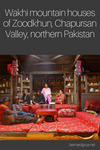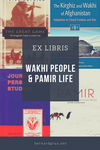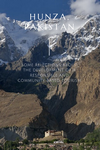High Asia, stories of the Karakoram

Collection of stories published on “Medium” about high valleys and mountains at the borders of Pakistan, Afghanistan and China. These different papers provide some background on geography, traditions, religion, history, geopolitics, communities, minorities, environment, external interactions, development issues and globalisation in this remote area.
How past and present religions built a tradition palimpsest in a high valley of northern Pakistan

Chapursan Valley, Pakistan, between Hindu Kush, Pamir and Karakoram ranges is mostly inhabited by Wakhi people, a small minority living in China and in Afghan or Tajik Wakhan. Not surpringly this population share a same faith and same religious traditions regardless the recent (on an historical point of view) borders. Read more…
Wakhi mountain houses of Zoodkhun in Chapursan Valley, northern Pakistan

Even though it experiences a, sometimes temporary, exodus to the big cities of southern Pakistan, Zoodkhun Village (also spelled Zuwudkhoon) is still well alive. Nowadays, numerous houses are being built or being enlarged. It is possible to observe a Pamiri layout dating back from Atash-Parast (Fire worshippers, Zoroastrians). This permanence could be due to religions (including old ones) but also due to a perfect adequation with environment constraints and ressources available in this remote area of Chapursan Valley (also spelled Chipurson, Chipursan, or Chapurson). Read more…
Portraits, Wakhi in relation with other people of their areas

The origin of the less than 100,000 Wakhi people is Wakhan corridor from where they emigrated but also where they, sometimes, partly came back. Their movements are explained by religion changes (Zoroastrian, Buddhism, Islam), trade, pastoralism, wars (Chinese, Tibetan, Arabs…), oppressions from local rulers (Wakhan Mirs), or more distant ones (Badakhshan Emirs, Bukhara Emirs, Yarkand Khan…), Afghanistan’s harsh annexion with the Pashtun Abdur Raman, Russian and Chinese communism, etc. Read more…
Wakhi people and Pamir life ex-libris

In this Ex-Libris are some selected readings about history, traditions, religion, way of life and geographical locations of Wakhi people in High Asia. It was prepared for the travelers who intend to visit the Gojal Valley (Upper Hunza, Pakistan) or Wakhan Corridor (Tajikistan & Afghanistan). It could, also, be a post-travel tool to organise ground observations and to see them in a wider perspective. Read more…
What to see and what to do in a short period of time in Hunza

This short program is intended for travelers who would like to visit Hunza, Pakistan, around the Karakoram Highway, even if they just have a few days. Though it is adapted for families with children, opportunities for photographers will be developed regarding conditions of light, most scenic spots and local people portraying. Read more…
The Great Game: Anglo-Russian encounter at the borders of Pamir, Hindu Kush and Karakoram

The last act of the “Great Game” or “Большая Игра” (Bolshaya Igra), was played where the Tsarist Empire, the British Empire and the Chinese Empire joined in one of the highest and, at that time, one of the most inaccessible places of the planet. There, bristling with giant mountains, Pamir, Hindu Kush and Karakoram ranges converge. Read more…
Zoodkhun Village in Chapursan Valley preserves a scenic and authentic mountain oasis landscape

At the top of Upper Hunza in an area called Gojal, Zoodkhun stretches in Chapursan Valley. Staying almost at the highest limit where vegetation of mountain oasis grows up, it is a village having numerous characteristics in common with other Wakhi settlements of Pakistan, Afghanistan, Tajikistan and, likely, China (though, not directly observed in this last country). However, its isolation at the very end of a narrow dirt road, coming from Sost, and its altitude of 3,300 m, make it, sometimes, different in term of tradition resilience, scenery, available resources and way of life. Read more…
Zoodkhun, Chapursan Valley, a life environment determined by altitude and remotness

At an altitude of 3,300 meters, Zoodkhun, the last hamlet of Chapursan Valley, is granted with less natural ressources and a more difficult access than most of other Wakhi villages of Hunza Valley. Although it creates harsh conditions for its inhabitants it means a pure, peaceful and clean environment in a pristine landscape. Read more…
Chapursan Valley, where Zoodkhun nights unveil the universe

Remote and isolated Zoodkhun, the high mountain village of Gojal in Gilgit Baltistan, is a remarkable place to observe and to photography night skies.
Read more…
What place for Zoodkhun into the global world?

Zoodkhun in Chapursan Valley, due to its difficult condition of access, preserved most of its authenticity and its community values until today. Expected improvement of communications, development of a Pakistani middle class, increase in foreign visitors might lead to deep changes which should be monitored to contain a cultural and patrimonial alienation. Read more…
Karakoram Highway, a prototype of the new Silk Roads?

The Chinese “Belt and Road Initiative” (BRI), also known as the “New Silk Roads”, is a work in progress that raises many questions. Yet in Pakistan, the Karakoram Highway, commissioned in 1979, may provide us with some answers. Parallel to the challenged sovereignty of the country, it could be observed, until these last months, a religio-patriotic discourse with a questionable consistency and an expensive open or latent state of war seeming to assure a form of national cohesion. Read more…
Some reflections about the development of a responsible and community based tourism in Hunza Valley

The aim of the following text is to present an external view resulting from an independent travel, made in August 2018, using public transportations from Islamabad to Khunjerab Pass with stops in different places. It is also an outcome of discussions hold with the people living and working in this mountainous area of Northern Pakistan. Read more…
Pamir Serai guest houses are the traditional homestay of Zoodkhun and Baba Ghundi for external visitors. They are run by the internationaly famous Alam Jan Dario’s family. There is a light version of Pamir Sreai guesthouses web site for traveler with a bad connection. For trekking on foot, horse or yak and for jeep tours in Northern Pakistan, ask Alam Jan Dario’s services via his tour company, Pamir trails.
Save this story presentation on Pinterest

